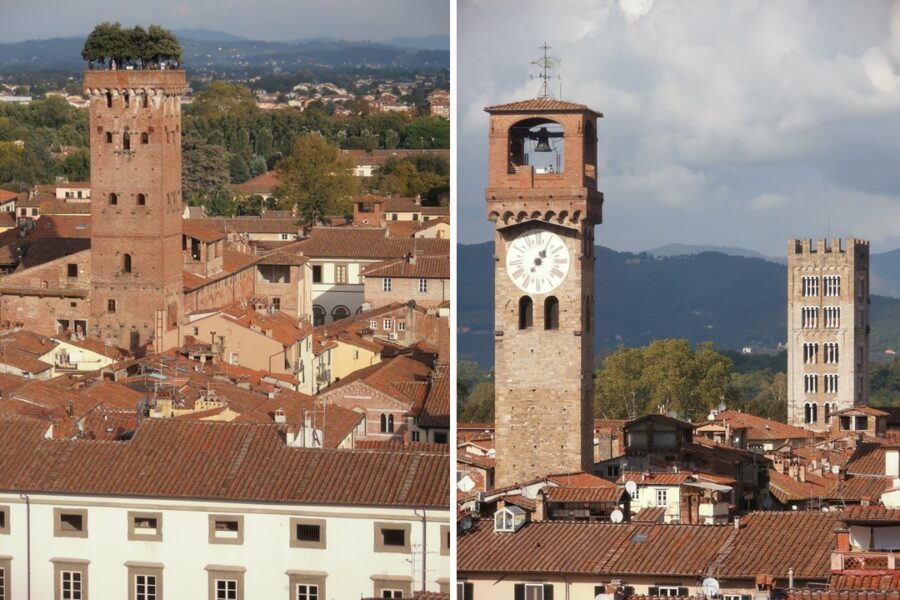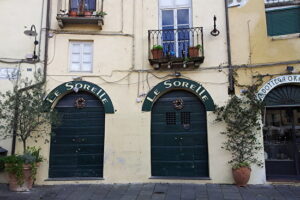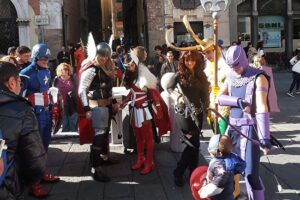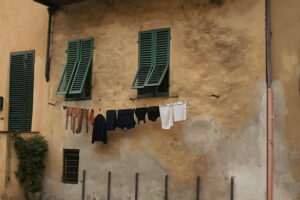Guinigi Tower
And why, I wonder, are two towers on our agenda today? If I had thought about it the answer is simple — because they are here; and because you can see two towers together cheaper than separately. And because Michael has a penchant for views from high places. I am only slightly acrophobic.
Normally I prepare myself for these ascents while on vacation. We always seem to be within a stone’s throw of the ocean, and lighthouses abound. But here — in Lucca — I thought I was safe from heights. We are in a valley, surrounded by mountains with no water anywhere!
So much for thinking.
Just down the street from our apartment, the Guinigi Tower rises above via Sant’ Andrea, taunting me every time I step out the door. I knew it was only a matter of time until we got to know each other.


In 1328, after the death of Castruccio Castracani, who conquered Lucca over a decade earlier, the rule of Lucca fell to the Guinigi family. At that time, the wealthy landowners began building towers onto their palace homes. It was an overt sign of their wealth and power and served as a defensive position and lookout. The tower building mania became an issue forcing many Tuscan towns to establish building limits on the height and style of the towers. In battles, destruction of the towers — often specifically targeted toward certain families — was common. It was also a blow to the pride of the town under attack.





The 234 steps are not as bad as I imagined until I get to the very end of the climb. At any rate, the view from the top is spectacular even if my knees are weak!
The Climb to the Top of Our Own Personal Tower



After our climb, we shop a bit then go home to rest before we tackle tower number two. However, our new home is a tower unto itself with sixty-four steps up to get to the top floor.
The Clocktower


Even the Clocktower has its own distinctive feature, the clock, in fact. The first clock was placed there in 1390, marking the hours with the striking of a bell. In 1752 the Republic of Lucca commissioned a new mechanism from the watchmaker Louis Simon from Geneva, placed on the top floor of the tower and after a detailed restoration, is still in working order.
We are told to listen just in case the bell rings during our visit! Small bells strike every quarter, and the largest bell marks each hour. However, as we climb to the top there is not a tick nor a tock nor a bell to be heard.
The 207 steps up to the top are rickety and worn. When I look straight down into the black depths of the tower my knees turn to jelly. My reward is the view of the angles atop the church of San Michele in Foro. Saint Michael follows us around the world.






Wine in Piazza Anfiteatro
To reward me for my heroic efforts in climbing two towers today, before returning home for the second time, and climbing our sixty-four steps once again, we stop off for a glass of wine in Piazza Anfiteatro.
All in all, we climbed 569 steps today! I deserve this wine!



Lucca’s Towers
Lucca’s towers were built during the mercenary-filled, post-plague years in Italy, when Tuscany was repeatedly turned upside-down by disease, raids, and outbursts of politically charged violence. It made sense for the powerful families of this time period to have a personal defensive tower. These towers were often used to symbolize strength, power, nobility, a strong soul, and an ancient dominion.
At one time, as many as 250 defensive tower houses graced the city’s skyline. Today, only about nine towers remain, and only two are opened to the public for their climbing pleasure.









Leave a Reply
Your email is safe with us.